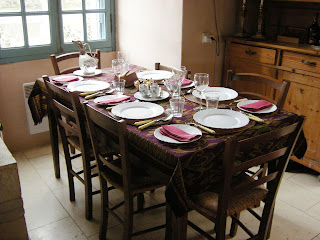Thanksgiving from Afar
-->
An ideal Thanksgiving Day – think YouTube video by Norman Rockwell – might begin with Macy’s Parade, featuring high school marching bands, elaborate floats, giant cartoon character balloons and Santa Claus. This is followed by a gathering of family and friends to partake of the annual feast, which usually includes some form of turkey and stuffing, cranberries, sweet potatoes, pumpkin pie and numerous other culinary delights.
After some strenuous overeating, drowsy-eyed men settle themselves in comfortable chairs in front of the television to watch a football game or two, while the women gather in the kitchen to wash the china and silver in preparation for round two, with should include sandwiches of sliced turkey, stuffing and cranberry relish, not to mention several additional helpings of dessert.
In less traditional households, such as mine, the men help in the kitchen, but this is my ideal Thanksgiving, so I see myself napping on the sofa with only passing interest in the National Football League game spread-out before me in high definition. Speaking of football, why is it always the Detroit Lions who play on Thanksgiving Day? Shouldn’t the game be between the New England Patriots and the Washington Redskins?
According to Kathleen Curtin, Food Historian at Plimoth Plantationn (sic, or yes that is spelled correctly), and History.com, “in 1621 the Plymouth St. Augustine , Florida
We are also told that the Thanksgiving “harvest meal has become a symbol of cooperation and interaction between English colonists and Native Americans.” This was certainly a rare moment of cooperation, because over the next several hundred years the European colonists and their descendents did everything possible to annihilate Native Americans from the continent.
Today, of course, there is no ideal Thanksgiving. Like everything in our culture the holiday is observed in ways that range from the highly spiritual to the commercial, to the cynical and on to the obscene. This season, for example, I received an e-card in the colors of autumn with a heartwarming message; numerous promotional materials encouraging me to buy, buy, buy; a copy of William Burroughs “Thanksgiving Prayer,” a political poem about the racism, bigotry and hatred that is still very much a part of our country; and a vulgar cartoon of a pumpkin-headed man producing pumpkin pies.
This year, however, my holiday was a Thanksgiving from afar, because this is the third year I have celebrated Thanksgiving outside of the United States Scotland Mexico , and this year we are in France
In Aberdeen , where there are a fair number of Americans because of the North Sea oil, Marks and Spencer’s gourmet grocery provided the essentials. In San Miguel de Allende, where one in ten residents is a Gringo, we dinned at a local hotel where the meal, although billed as a Thanksgiving feast, was prepared by a chef who had no idea what made a good Turkey Day dinner. And this year, in Saint-Pierre-de-Maillé, Cindy prepared an exceptional meal for a table of five, five people that included three vegetarians and a good hostess. I was the odd man out. Personally, I think vegetarians should give themselves a day off once or twice a year and not pretend that tofu turkey tastes good.
Despite heroic efforts, expatriate Thanksgivings just never seem to achieve U.S. France
There were no parades, no football games and no Black Friday on which to max out the family credit cards. One benefit of being in Europe was being spared having to watch my alma mater, Florida State
What seems odd at an expatriate Thanksgiving is the fact that in a world where America has been exporting music, movies and contemporary culture for decades, where so many aspects of American life have become international, this particular holiday remains unknown outside the borders of North America .
Thanksgiving is uniquely American, and personally I think that is a good thing. One of the reasons I enjoy travel is because it offers me the opportunity to gain difference perspectives of the world, discover celebrations that are rarely observed in the United States – such as Mexico ’s Day of the Dead and Britain Iowa or Alabama
As a traveler, I think there should be new and different experiences for those who visit the U.S.


I think Canadian Thanksgiving is in October. Don't the French have some holiday with the specific point being to overeat?
ReplyDeleteYou are correct. Thanksgiving in Canada is in October. Being further north, they get the crops in earlier. I never found French holiday to match.
ReplyDelete